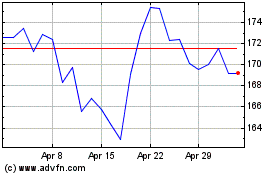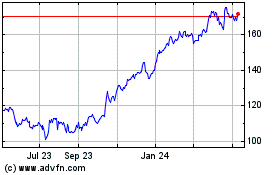Allstate Corporation’s (ALL) third quarter 2011
operating earnings of 16 cents per share came in a nickel higher
than the Zacks Consensus Estimate of 11 cents but significantly
lagged the year-ago quarter’s earnings of 83 cents per share.
Results for the quarter reflected higher catastrophe (CAT)
losses that also led to increased claims expenses coupled with
lower average premiums and policies-in-force in Property-Liability
insurance unit and lower investment income. However, prudent
capital management and liquidity were quite impressive during the
reported quarter. This is reflected from stability in book value
per share and combined ratio, excluding the effect of
catastrophes.
Allstate’s net income for the reported quarter came in at $165
million or 32 cents per share, compared with $367 million or 68
cents per share in the prior-year quarter, reflecting a radical
decline.
Operating income, which excludes realized net capital gains and
losses and deferred acquisition costs (DAC) and DSI related to them
along with valuation changes on embedded unhedged derivatives,
gains and losses on disposition of operations and accruals on
unhedged derivative instruments, plunged to $84 million against
$452 million in the year-ago quarter.
Allstate reported total net revenue growth of 4.2% year over
year to $8.24 billion but substantially exceeded the Zacks
Consensus Estimate of $6.90 billion. Besides, property-liability
insurance claims and claims expenses grew 11.5% year over year to
$5.13 billion while operating costs and expenses remained almost
flat at $825 million.
Particularly, catastrophe losses for the reported quarter
escalated to $1.08 billion, in line with management’s projection,
contributing 15.6 point to the combined ratio but were
substantially higher than $386 million in the year-ago period.
During the reported quarter, Allstate experienced 23 catastrophe
loss events including Hurricane Irene and Tropical Storm Lee.
Quarter in Detail
Property-Liability net written
premiums were $6.73 billion, inching down 0.6% from the prior-year
quarter. The segment’s combined ratio was 104.8% against 95.9% in
the year-ago quarter, reflecting increased catastrophe losses.
However, the underlying combined ratio, which excludes
catastrophes and prior-year reserve estimates, was 89.2% in the
reported quarter, flat from the year-ago quarter. This was also
within management’s outlook of underlying combined ratio of 88 to
91 for 2011.
Besides, Allstate brand standard auto premiums written for the
reported quarter declined 0.8% from the prior-year quarter as a
result of a fall in policies in force along with a 13.2% decline in
new issued applications. Average gross premium also dipped 1.1%
from the year-ago period, reflecting slight rate increases offset
by reduced volumes in vast markets of New York and Florida. As a
result, the Allstate brand standard auto combined ratio increased
1.0 point year over year to 94.2%.
Nevertheless, Allstate-branded homeowners’ written premiums for
the quarter improved 1.5% year over year, reflecting a 5.0% climb
in average gross premium that was partially mitigated by a 4.2%
decline in policies in force. Higher catastrophe losses resulted in
Allstate-branded homeowners combined ratio of 131.9%, although
underlying combine ratio moderated marginally to 73.3% against
75.0% in the prior-year quarter.
Property-Liability net income sank to $40 million against $331
million in the year-ago quarter. Operating income for this segment
was $21 million, decreasing from $394 million in the year-ago
quarter. However, the Property-Liability expense ratio for the
reported quarter improved marginally to 25.0 from 25.1 in the
prior-year quarter.
However, operating income for Allstate
Financial spiked 24.1% year over year to $134
million. The increase reflected improvement in the profitability of
investment spread products along with expansion of underwritten
products sales through Allstate agencies and growing Allstate
Benefits. Meanwhile, net income came in at $183 million against $85
million in the year-ago quarter, primarily driven by lower
operating costs and net realized capital gains in the reported
quarter against losses, in the comparable period.
Corporate & Other segment reported
a net income of $165 million, deteriorating from $367 million in
the prior-year quarter. Total operating cost and expenses stood at
$116 million, climbing from $95 million in the year-ago
quarter.
Investment and Capital Position
As of September 30, 2011, Allstate’s total investment portfolio
decreased $3.0 billion from 2010-end to $97.5 billion, reflecting
reductions in the Allstate Financial portfolio and its fixed
annuity business. However, the pre-tax net unrealized capital gains
jumped to $2.4 billion as on September 30, 2011 from $1.4 billion
at the end of 2010. Meanwhile, net realized capital gains totaled
$264 million compared to a loss of $144 million in the year-ago
period, primarily due to sales of foreign government and the U.S.
Treasury securities, which were partly offset by interest rate
derivatives losses.
Allstate’s net investment income came in at $994 million, down
1.1% from the year-ago quarter, although portfolio yields were
stable at 4.5%. As on September 30, 2011, reported book value per
share inched up 0.2% year over year to $35.56. Book value per
share, excluding the impact of unrealized net capital gains and
losses on fixed income securities, was almost flat at $33.39.
Operating cash flow totaled $1.67 billion at the end of the
reported quarter, significantly down from $3.02 billion at the end
of the prior-year quarter. Long-term debt stood at $5.9 billion and
total equity was $18.1 billion, while total assets were recorded at
$127.0 billion at the end of September 30, 2011.
Additionally, during the reported quarter, Allstate repurchased
shares worth $308 million, thereby completing the $1.0 billion
share repurchase program that was authorized in November 2010. The
company has deployed about $20 billion of capital through share
repurchases over the last 17 years.
Outlook
Management expects to maintain the profitability of the auto
business and improve homeowners’ profitability, resulting in an
underlying combined ratio outlook of 88% to 91% for 2011.
Meanwhile, Allstate aims to generate long-term shareholder value
and an operating return on equity (ROE) of 13% by 2014. As a
long-term growth strategy, management also plans to reposition
products and distribution platforms to meet changing needs of
consumers. Besides, the company’s near-term priorities include
maintaining standard auto margins, improving returns in homeowners
and Allstate Financial and managing capital aggressively.
Allstate is taking strategic actions to reduce losses for
Allstate business from catastrophes through enhanced property
catastrophe reinsurance program, non-renewals, stricter
underwriting guidelines, increased deductibles and discontinuance
of selected lines of coverage, including earthquake.
We anticipate continued benefits from Allstate’s
diversification, superior financial strength rating and proactive
approach to investment. These factors have helped Allstate gain the
second-largest personal lines writer position in the US, which also
reflects its competitive strength against arch rivals such as
Berkshire Hathaway-B (BRK.B) and The
Travelers Companies (TRV).
However, Allstate’s exposure to catastrophe risks, capital
losses and volatility in pricing, interest and loss costs will
continue to impact the premiums and investment portfolio in the
upcoming quarters.
ALLSTATE CORP (ALL): Free Stock Analysis Report
BERKSHIRE HTH-B (BRK.B): Free Stock Analysis Report
TRAVELERS COS (TRV): Free Stock Analysis Report
Zacks Investment Research
Allstate (NYSE:ALL)
Historical Stock Chart
From Jun 2024 to Jul 2024

Allstate (NYSE:ALL)
Historical Stock Chart
From Jul 2023 to Jul 2024
